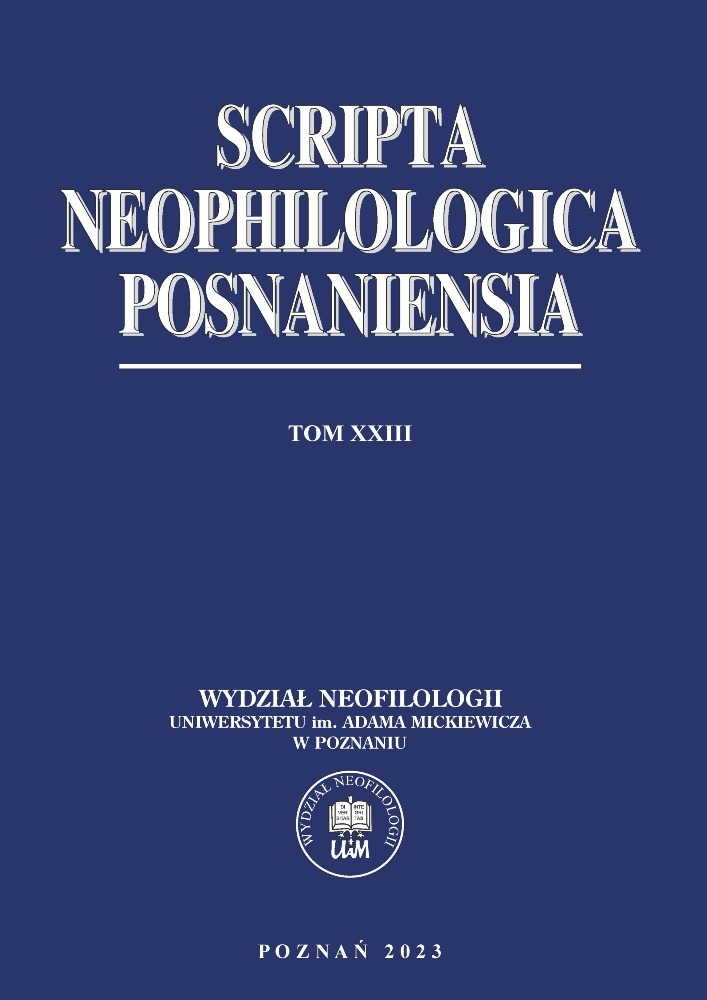Abstract
The aim of the article was to examine discursive and textual mechanisms used to construct masculinity in selected Italian men’s magazines published in 2022–23. The excerpted corpus was examined according to the social theory of gender by R.W. Connell. The analysis showed a significant presence of male anthroponyms, reproducing the image of five diverse hegemonic masculinities. A meaningful number of onymic units cocreating subordinate and marginalized masculinities (disability, illness, age, or lack of typi- cally masculine physical features) was noted. The study confirmed that complicit masculinity in the onomastic sense is an anonymous category (lack of individual descriptions).
References
Boni, F. (2002). „Framing media masculinities: men’s lifestyle magazines and the biopolitics of the male body”. European Journal of Communication 17(4), 465–478. DOI: https://doi.org/10.1177/02673231020170040401
Clarke, L.H., Bennett, E.V. i C. Liu. (2014). „Aging and masculinity: portrayals in men’s magazines”. Journal of Aging Studies 31, 26–33. DOI: https://doi.org/10.1016/j.jaging.2014.08.002
Connell, R.W. (2005). Masculinities. Cambridge: Polity Press.
Connell, R.W. i J.W. Messerschmid. (2005). „Hegemonic masculinity: rethinking the concept”. Gender and Society 19(6), 829–859. DOI: https://doi.org/10.1177/0891243205278639
Frederick, D.A., Fessler, D.M.T. i M.G. Haselton. (2005). „Do representations of male muscularity differ in men’s and women’s magazines?”. Body Image 2, 81–86. DOI: https://doi.org/10.1016/j.bodyim.2004.12.002
Gauntlett, D. (2002). Media, gender and identity. An Introduction. London-New York: Routledge. Melosik, Z. (2002). Kryzys męskości w kulturze współczesnej. Poznań: Wydawnictwo Wolumin.
Pompper, D., Soto, J. i L. Piel. (2007). „Male body image and magazine standards: considering dimensions of age and ethnicity”. Journalism and Mass Communication Quarterly 84(3), 525–545. DOI: https://doi.org/10.1177/107769900708400308
Ricciardelli, R., Clow, K.A. i P. White. (2010). „Investigating hegemonic masculinity: portrayals of masculinity in men’s lifestyle magazines”. Sex Roles 63(1-2), 64–78. DOI: https://doi.org/10.1007/s11199-010-9764-8
Rohlinger, D.A. (2002). „Eroticising men: cultural influences on advertising and male objectification”. Sex Roles 46(3), 61–74. DOI: https://doi.org/10.1023/A:1016575909173
Skoczylas, Ł. (2011). „Hegemoniczna męskość i dywidenda patriarchatu. O społecznej teorii płci kulturowej Raewyn Connell”. Refleksje 4, 11–18. DOI: https://doi.org/10.14746/r.2011.4.01
Skowronek, K. (2016). Kultura konsumpcji. Kultura terapii. Studia językoznawcze. Kraków: Wydawnictwo LIBRON.
Zierkiewicz, E. (2008). „Czasopisma life-stylowe dla mężczyzn – pozorna opozycja dla prasy kobiecej”. Studia Socjologiczne 1, 45–75.
License
Copyright (c) 2023 Joanna Ozimska

This work is licensed under a Creative Commons Attribution-NoDerivatives 4.0 International License.

